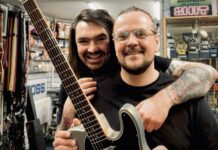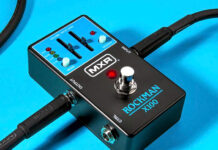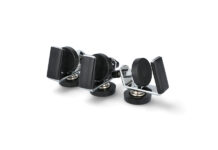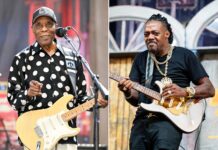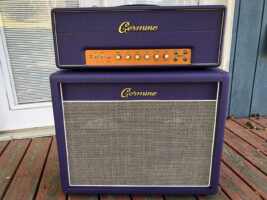
Greg Germino of Germino Amplification on vintage Marshall tones, Southern rock and finding “magic” in original tweed amp circuits
The chances are that if you’ve gone in search of vintage Plexi or JTM45-style tones and wanted the best you could get but didn’t actually want to purchase vintage, that road led you eventually to Greg Germino’s door. We all know that different players quests for the Marshall tone can express desires for very different sounds; but when you want a new amp that sounds like the real thing circa 1968 or so, a high proportion of players who know their Plexis will tell you to track down a Germino.
READ MORE: Invention & Evolution: Charles Darwin, Henry Ford and how the death of silent movies birthed the guitar amplifier
The attention to detail – and often to details that few others even know about – has landed Germino amps in the backlines of Charlie Starr, Earl Slick, Brad Whitford, Audley Freed, Jimmy Herring and a host of other stars. Put simply, Greg’s amps are built like the real deal, they look like the real deal, and most importantly they sound like the real deal – mostly because he’s seen inside more real-deal Marshalls from the golden era than just about anyone, other than the people who made them in the first place.
Germino was born in Durham, North Carolina, in 1958 and grew up across the street from the East Campus of renowned Duke University, through which countless classic rock bands would pass on their college-circuit tours of the following two decades. So, if it was The Beatles on The Ed Sullivan Show that triggered the young enthusiast to start jumping round the living room thrashing air guitar in the early 60s, it was the full-on live experience in the heyday of Southern rock that really hooked him in his teens.
“The quantum shift was when I went to see the Allman Brothers, February 1972, after Duane Allman passed,” he tells us. “I went to see that show at Cameron Indoor Stadium at Duke University, we could take the free bus from the East Campus to the West Campus and get dropped off right at the venue. I had just turned 14, and I took my little Sony cassette player that I’d been listening to this other stuff on, and recorded the show. I was just floored. I was totally knocked out by them. And that was the rare five-man-band version of the Allmans, way before Chuck Leavell came in.
“I basically learned how to play guitar from that cassette tape. I wore it out. I’d splice it back together and stuff like that. So, really between the age of 14 and 15 I graduated from acoustic guitar into electric guitar, and by the time I was 16 I was playing in a band with people.”
Burst bubble
Like so many big Southern rock acts of the day, the Allmans were major promoters of the Marshall tone. But they also helped fire up another desire that burned in every teenage wannabe guitar star of the era. If you wanted to do it right, you had to do it on a Burst, and Germino was no different – but even back then both the amp and guitar of choice were pretty hard to come by.
“My first amp was an Ampeg B-12 XT Portaflex flip-top, a ’67 with a couple 12-inch Jensens,” Germino recalls. “That was a nice amp. I had gone through a couple of guitars at that point, but I was playing a Les Paul Goldtop with P-90s in it. Where we were, $350 to $450 was the going rate for a [non-vintage] Les Paul. I had a ’68 or ’69 Custom that was not a great guitar. And then I answered an ad in the paper, the guy said ‘Gibson Les Paul, $350.’ I go over there, it’s in a brown case. I open it up, and it’s a ’59 Les Paul but it had been brush painted. You couldn’t even see the grain in the top wood. It was non-existent.
“I paid him $350 for it, thanks to my grandparents, and sold the Custom to the guy who I was playing with in the band. I played that guitar for about a year and a half, and when I sanded the cruddy brush-paint finish off it everybody came out of the woodwork and wanted to buy it, and I foolishly traded that for the Goldtop with P-90s in it.
“You know, I was 15 years old, hindsight being 20-20, yeah, that guitar would be very valuable these days. But the thing was, and this is the important thing to remember, it was that time period. It was 1973-74. Guitars were $350. I bought an SG with a sideways tremolo, same amount of money, from a college student. Later on, I bought a ’58 Strat for $450. Found out that I hated Stratocasters, I just didn’t bond with them. But that was just the going rate. A Les Paul Junior was a hundred bucks.
“I was writing George Gruhn at Gruhn Guitars at the time. I wanted a sunburst Les Paul, and this would have been ’74, ’75, ’76, somewhere in there. And I still have three letters from them, and a sunburst Les Paul from Gruhn’s back then was between $2,500 to $2,800. And the most expensive thing that they had was an Explorer, and it was $4,000. So that just puts things into perspective.”
All the while, our hero was also getting serious about electronics, aceing his high-school classes in a number of engineering-based subjects, and heading toward a career as a technician specialising on DC circuits. It’s no great leap, though, to see how this would pull him inside the chassis of his own Marshall amps, and others… once he could get his hands on them.
Marshall mystique
Rare as they were, vintage Les Pauls were at least American-made. The amp of choice being a British import, however, meant relying on the foibles of distribution, and the occasionally quixotic history of Marshall’s commercial inroads into North America. The New York-based Unicord company helped ensure better availability after acquiring the US distributorship around 1968, but according to Germino that meant earlier amps were still hard to come by for many years.
“Primarily what was available in this area was a trickle down of Marshall amplifiers that probably came from Manny’s, because Unicord was the distributor and that was in New York,” he says. “So most of the stuff that we were seeing was coming down from that way. We didn’t see a lot of Marshalls earlier than ’68 or ’69, and the majority of those were Lead circuit amps, 50- and 100-watters. So that was what we were cutting teeth on down here.”
Germino acquired his own first Marshall, a 50-watter, in 1977, but being a kid in the era of loud, that didn’t quite scratch the itch. Soon after he traded up to a ’74 MkII 100-watter, only to realise how loud 100 watts of raging Marshall really was. “‘Oh my god, it’s blisteringly loud!’ So then I figured out we could yank two of the power tubes and run it at 50.”
He also knew by then, as the adage so often went, that the old ones supposedly sounded better than the newer ones. Putting his ’74 up on the bench alongside a friend’s earlier Plexi provided his first real glimpse into the essentials of the tone, and kicked off a decades-long adventure in discerning the best of the golden era of British rock amplification.
“I should say,” Germino elaborates, “everything from those days is a little foggy – and when I say ‘foggy’ I mean smokey, because that’s just what we were doing back then – but we opened up my Marshall and at the time he had a better understanding than I did, but I was really keen to learn about that stuff. We sussed out what was there and changed some components in that ’74 and did make it sound a whole lot better.”
As he worked the day job in DC electronics through the 80s, Germino kept playing, and kept buying vintage Marshalls. As different and more unusual pre-Unicord circuits cycled through he got his hands on gems such as a JTM45/100, a ’68 Super Tremolo, and a variety of Bass circuit heads, and soon he’d compiled the knowledge and experience to make him the go-to guy for any and all Marshall work in this part of the southern mid-Atlantic states.
Lead me on
Although different classic tones come to mind depending on which player you’re referencing, and from when, most people’s touchstone for ‘that sound’ comes from the Plexi-era Lead circuit, and Germino is well primed to tell us how that differs from the tweed-Bassman-derived circuit that kicked off the line in ’62 with the JTM45.
“There’s seven different components there that were changed,” he reveals. “The output stage coupling caps changed in value, the tone stack components changed in value, the output stage couplers went from .1 to .022, so that’s letting less low end through. The tonestack components changed in that Lead value, which was adopted in so many other amps later on. So, that pushes where your tone controls’ EQ are working.
“Then probably the biggest thing was the preamp, because they went from a shared-cathode design to a split-cathode design; that’s where channel one gets its own resistor and bypass cap, which is a different value from channel two. Back in the Plexi days the split cathode on the channel one side was 820 ohms. You don’t see the 2.7k cathode resistor for channel one coming in until you’re several months into the metal-panel era, which would be after mid ’69, June, July, August, somewhere in there. I try to get real specific about this stuff because I’m basing what I tell you on things that I’ve actually seen in person, not on a picture.
“And then additionally, you know, they’re really trying to voice these things for lead guitar, the coupling cap for channel one is also a different value. And I would be remiss if I didn’t say, ‘Hey, don’t forget the bright cap.’ Because the bright cap on channel one, that was probably the thing that changed the voice of it more than anything. A bright switch on a Fender is 120 pico-farad, basically. A bright cap on a Lead Marshall: 5,000 pico-farad, which is .005 micro-farad, and what that does is strips out a lot of low-end in that preamp section and makes the amp crunch really early. And that specific bright-cap component is why you begin to see people bridging channel one into channel two on Marshall amps. But you can really just break down the Marshall amps into those two circuits.
“I think most people are going to gravitate toward the Lead circuit more than anything else because you can do everything you want to do with it. And you can plug channel two and pretty much get a Bass circuit sound just like Eric Clapton used in Cream. Clapton was plugging into the top input of channel two. If you go look at this stuff, Clapton’s playing those 45/100s plugged into channel two, and even the later stuff, Cream Live, he’s still plugged into channel two. He just preferred that rounder tone that you get from that Bass circuit.”
Transformers to tweeds
Aside from getting the circuit details right, there are hundreds of variables in components and construction techniques that contribute to dialling in any amp – and screwing up just one of them can get it entirely wrong. Of the parts that matter most, Germino tells us some might be obvious, while others are more unassuming:
“Transformers are number one. I use Heyboer and Mercury Magnetics, specifically for certain models, and they’re both great. I think they’re of comparable quality and sound equally as good in the models that I use them in. That’s number one.
“Another thing that I try very hard to do is I spend a lot of time looking for NOS tube sockets, because I am not real crazy about a lot of the newer tube sockets that are standard, that pretty much everybody uses. I’ll search out some old Cinch or EBY octal or preamp sockets, because that was a sore point in the 100-watt Marshalls. Those McMurdo sockets, I mean they’re just ‘okay.’ People charge big money for ’em now for restorations if you can find ’em, and supplies of them have sort of dried up, but that was not a great tube socket when you’re running 500 volts at the plate. And that doesn’t make a difference in sound, but it does make a difference in terms of reliability.
“Other things, your voltages and your filtering, the current capacity of the power transformer, all of those are equally as important.”
As alluded to earlier, the big Plexi-style circuits can mean big volume. To help alleviate the sound pressure levels, Germino will make one allowance to modern requirements by adding an optional master volume. For this, he likes a dual-ganged potentiometer placed in the post-phase-inverter position (the so-called PPIMV), which has become standard with many makers.
Otherwise, when it’s important to keep it to sub-stack decibel levels, Germino has lately gone a different direction entirely.
“My dealer at the Amp House, Chris, asked me to consider doing some tweed Deluxe builds,” he tells us, “and I was like, ‘I’ve got to research it!’ I’m not going to just come out of pocket and do it, because there are a lot of really good people doing that already: Victoria, Clark, the Tungsten Crema Wheat, Rondo’s Speed Shop, he does a really nice amp.
“So, I’m fortunate to have a lot of friends who had a lot of money and bought a lot of amplifiers over the years that I had access to. I brought in a couple of old tweed Deluxes and some other variants that people loaned me. I just looked them over, and they were all really nice, and were all more similar than dissimilar, but I found out real quick there’s just some magic to the original circuit. You don’t want to deviate too far from that, because that amp is what it is. It’s probably one of the greatest recording amps of all time.”
In the few years since the Tweed Deluxe launched, Germino has also offered a 5F6A Bassman, 5F4 Super, and 5E7 Bandmaster, and he himself has often turned to these models in the band in which he still gigs as often as two or three times a week.
“They do help to keep the volume down in the smaller clubs,” he concludes, “and still sound great in the process.”
Visit germinoamplification.com for more.
The post Greg Germino of Germino Amplification on vintage Marshall tones, Southern rock and finding “magic” in original tweed amp circuits appeared first on Guitar.com | All Things Guitar.
Source: www.guitar-bass.net



